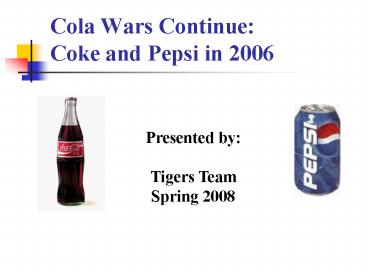Cola Wars Continue: Coke and Pepsi in 2006 - PowerPoint PPT Presentation
Title:
Cola Wars Continue: Coke and Pepsi in 2006
Description:
Pepsi was created in 1893 in North Carolina by Pharmacist Caleb Bradham. ... In a five year span, Dr Pepper was sold several times, Canada Dry twice, Sunkist ... – PowerPoint PPT presentation
Number of Views:516
Avg rating:3.0/5.0
Title: Cola Wars Continue: Coke and Pepsi in 2006
1
Cola Wars ContinueCoke and Pepsi in 2006
Presented by Tigers Team Spring 2008
2
Overview
- History
- Historical Industry Profitability
- Concentrate vs. Bottler Profitability
- Competition between Coke and Pepsi
- Sustaining Profits
3
History of Pepsi
- Pepsi was created in 1893 in North Carolina by
Pharmacist Caleb Bradham. - By 1910 Pepsi had built a network of 270
bottlers. - Pepsi struggled and declared bankruptcy twice
- During Great Depression grew in popularity due
to price decrease to a nickel. - In 1938, Coke sued Pepsi-Cola brand for
infringement on Coca-Colas trademark.
4
History of Coca-Cola
- Coca-Cola was formulated in 1886 by pharmacist
John Pemperton who sold the product at drug
stores as potion for mental and physical
disorders. - In 1891, Asa Candler acquired the formula,
established a sales force and began brand
advertising of Coca-Cola. - In 1919, went public under control of Robert
Woodruff expanded and developed in national and
international markets. - Successful during WWII with the high CSD
consumption from the U.S soldiers.
5
Industry Profitability Porters Five Forces
- Rivalry
- Coke
- Pepsi
- Cadbury
- Substitutes
- Alliances
- Acquisitions
- Product Innovation
6
Porters Five Forces (Cont.)
- Barriers to Entry
- Exclusive Territories
- Substantial Investment
- Current Market Presence
- Power of Suppliers
- Sugar
- Packaging
7
Porters Five Forces (Cont.)
- Power of Buyers
- Super Markets
- Convenience and Gas
- Mass Merchandisers
- Fountain
- Vending
- Fast Food
- Profitability of the CSD Industry
8
Concentrate Business vs. Bottling Business
- Concentrate Producers
- Blend raw material ingredients
- Packaged Mixture in plastic canisters
- Shipped to bottlers
- Diet CSDs
- Added artificial sweeteners
9
Concentrate Business vs. Bottling Business
- Bottlers
- Purchased Concentrate
- Added carbonated water and high fructose corn
syrup - Bottled CSD product
- Delivered to customers accounts
- Diet CSDs
- Added sugar or high-fructose corn syrup
10
Concentrate Business vs. Bottling Business
- Concentrate Producer
- Little Capital Investment
- Cost of 25 million - 50 million
- One plant to serve US
- Significant cost-advertising, promotion, market
research and bottler support
- Bottlers
- Capital Intensive
- High-speed production lines
- Bottling costs 4 million to 10 million
- Capacity of 40 million warehouse cost 75
million - Coke and Pepsi each require 100 plants
- Pressure from Coke/Pepsi
11
Bottler Consolidation
- Bottler plants decreased in the US
- 2000 plants to 300 from 1970-2004
- Cokes re franchising bottling operations
- Buying Poor managed bottlers
- Infusing with capital
- Selling to large bottling plants
- In 1985, Coke purchased two of the largest
bottling companies - Vertical integration
12
Affects on Industrys Profits
- Coke was the first concentrate producer to build
a nationwide franchise bottling network, that
Pepsi and Cadbury Schweppes followed suit. - Franchise agreements with both Coke and Pepsi
allowed bottlers to handle the non-cola brands of
other concentrate producers. - Bottlers could not carry directly competing
brands.
13
Affects on Industrys Profits (Cont.)
- Throughout the 1980s, the growth of Coke and
Pepsi put a squeeze on smaller concentrate
producers - Shelf space for small brands declined and were
shuffled from one own to another.
14
Affects on Industrys Profits (Cont.)
- In a five year span, Dr Pepper was sold several
times, Canada Dry twice, Sunkist once, Shasta
one, and AW once. - Phillip Morris acquired Seven-UP in 1978 for a
big premium, but racked up huge losses in the
early 1980s, and then left the CSD business in
1985.
15
Affects on Industrys Profits (Cont.)
- In 1990s, through a series of strategic
acquisitions, Cadbury Schweppes became the
third-largest concentrate product. - Coke has a world market share of 51.4, Pepsi has
21.8 and Cadbury Schweppes has 6
16
Sustaining Profits
- Shift to non-carbonated beverages (keep up with
demand of health conscious society) - Continue on current path and see where it leads
17
U.S. Liquid Consumption Trends
18
THE END

